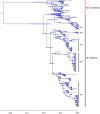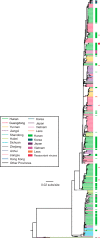Molecular Evolution and Emergence of H5N6 Avian Influenza Virus in Central China
- PMID: 28404845
- PMCID: PMC5446651
- DOI: 10.1128/JVI.00143-17
Molecular Evolution and Emergence of H5N6 Avian Influenza Virus in Central China
Abstract
H5N6 avian influenza virus (AIV) has posed a potential threat to public health since its emergence in China in 2013. To understand the evolution and emergence of H5N6 AIV in the avian population, we performed molecular surveillance of live poultry markets (LPMs) in Wugang Prefecture, Hunan Province, in central China, during 2014 and 2015. Wugang Prefecture is located on the Eastern Asian-Australian migratory bird flyway, and a human death due to an H5N6 virus was reported in the prefecture on 21 November 2016. In total, we sampled and sequenced the complete genomes of 175 H5N6 AIVs. Notably, our analysis revealed that H5N6 AIVs contain at least six genotypes arising from segment reassortment, including a rare variant that possesses an HA gene derived from H5N1 clade 2.3.2 and a novel NP gene that has its origins with H7N3 viruses. In addition, phylogenetic analysis revealed that genetically similar H5N6 AIVs tend to cluster according to their geographic regions of origin. These results help to reveal the evolutionary behavior of influenza viruses prior to their emergence in humans.IMPORTANCE The newly emerged H5N6 influenza A virus has caused more than 10 human deaths in China since 2013. In November 2016, a human death due to an H5N6 virus, in Wugang Prefecture, Hunan Province, was confirmed by the WHO. To better understand the evolution and emergence of H5N6 viruses, we surveyed live poultry markets (LPMs) in Wugang Prefecture before the reported human death, with a focus on revealing the diversity and genomic origins of H5N6 in birds during 2014 and 2015. In general, H5N6 viruses in this region were most closely related to H5N1 clade 2.3.4.4, with the exception of one virus with an HA gene derived from clade 2.3.2 such that it represents a novel reassortant. Clearly, the ongoing surveillance of LPMs is central to monitoring the emergence of pathogenic influenza viruses.
Keywords: H5N6; avian influenza virus; evolution; molecular epidemiology; reassortment.
Copyright © 2017 American Society for Microbiology.
Figures




Similar articles
-
Genesis, Evolution and Prevalence of H5N6 Avian Influenza Viruses in China.Cell Host Microbe. 2016 Dec 14;20(6):810-821. doi: 10.1016/j.chom.2016.10.022. Epub 2016 Dec 1. Cell Host Microbe. 2016. PMID: 27916476
-
Genetic analysis and biological characteristics of different internal gene origin H5N6 reassortment avian influenza virus in China in 2016.Vet Microbiol. 2018 Jun;219:200-211. doi: 10.1016/j.vetmic.2018.04.023. Epub 2018 Apr 18. Vet Microbiol. 2018. PMID: 29778197
-
Unique phenomenon of H5 highly pathogenic avian influenza virus in China: co-circulation of Clade 2.3.4.4b H5N1 and H5N6 results in diversity of H5 Virus.Emerg Microbes Infect. 2025 Dec;14(1):2502005. doi: 10.1080/22221751.2025.2502005. Epub 2025 May 12. Emerg Microbes Infect. 2025. PMID: 40326336 Free PMC article.
-
The genetics of highly pathogenic avian influenza viruses of subtype H5 in Germany, 2006-2020.Transbound Emerg Dis. 2021 May;68(3):1136-1150. doi: 10.1111/tbed.13843. Epub 2020 Sep 29. Transbound Emerg Dis. 2021. PMID: 32964686 Review.
-
Epidemiology, Evolution, and Recent Outbreaks of Avian Influenza Virus in China.J Virol. 2015 Sep;89(17):8671-6. doi: 10.1128/JVI.01034-15. Epub 2015 Jun 10. J Virol. 2015. PMID: 26063419 Free PMC article. Review.
Cited by
-
Novel reassortant 2.3.4.4B H5N6 highly pathogenic avian influenza viruses circulating among wild, domestic birds in Xinjiang, Northwest China.J Vet Sci. 2021 Jul;22(4):e43. doi: 10.4142/jvs.2021.22.e43. Epub 2021 May 11. J Vet Sci. 2021. PMID: 34170087 Free PMC article.
-
Genetic evolution and molecular characteristics of avian influenza viruses in Jining from 2018 to 2023.Front Microbiol. 2025 Mar 27;16:1551617. doi: 10.3389/fmicb.2025.1551617. eCollection 2025. Front Microbiol. 2025. PMID: 40212390 Free PMC article.
-
Using homologous network to identify reassortment risk in H5Nx avian influenza viruses.PLoS Comput Biol. 2025 Jul 22;21(7):e1013301. doi: 10.1371/journal.pcbi.1013301. eCollection 2025 Jul. PLoS Comput Biol. 2025. PMID: 40694591 Free PMC article.
-
Zoonotic Potential of Influenza A Viruses: A Comprehensive Overview.Viruses. 2018 Sep 13;10(9):497. doi: 10.3390/v10090497. Viruses. 2018. PMID: 30217093 Free PMC article. Review.
-
Avian influenza viruses (AIVs) H9N2 are in the course of reassorting into novel AIVs.J Zhejiang Univ Sci B. 2018 May;19(5):409-414. doi: 10.1631/jzus.B1700374. J Zhejiang Univ Sci B. 2018. PMID: 29732752 Free PMC article.
References
-
- Li KS, Guan Y, Wang J, Smith GJ, Xu KM, Duan L, Rahardjo AP, Puthavathana P, Buranathai C, Nguyen TD, Estoepangestie AT, Chaisingh A, Auewarakul P, Long HT, Hanh NT, Webby RJ, Poon LL, Chen H, Shortridge KF, Yuen KY, Webster RG, Peiris JS. 2004. Genesis of a highly pathogenic and potentially pandemic H5N1 influenza virus in eastern Asia. Nature 430:209–213. doi:10.1038/nature02746. - DOI - PubMed
-
- Wong FY, Phommachanh P, Kalpravidh W, Chanthavisouk C, Gilbert J, Bingham J, Davies KR, Cooke J, Eagles D, Phiphakhavong S, Shan S, Stevens V, Williams DT, Bounma P, Khambounheuang B, Morrissy C, Douangngeun B, Morzaria S. 2015. Reassortant highly pathogenic influenza A(H5N6) virus in Laos. Emerg Infect Dis 21:511–516. doi:10.3201/eid2103.141488. - DOI - PMC - PubMed
Publication types
MeSH terms
Substances
LinkOut - more resources
Full Text Sources
Other Literature Sources
Medical
Miscellaneous

